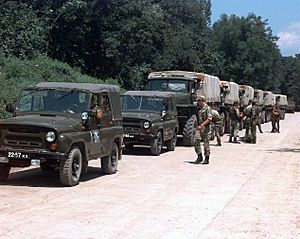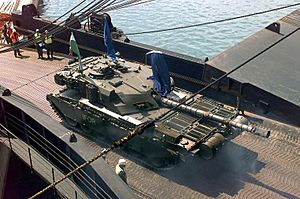IFOR facts for kids
Quick facts for kids Implementation Force |
|
|---|---|

Pocket badge of the IFOR
|
|
| Active | 1995–1996 |
| Country | 32 countries |
| Type | Command |
| Part of | NATO |
The Implementation Force (IFOR) was a special military group led by NATO. Its job was to help bring peace to Bosnia and Herzegovina. IFOR worked for one year, from December 20, 1995, to December 20, 1996. This mission was called Operation Joint Endeavour.
Contents
Why IFOR Was Needed
IFOR was created to help carry out the Dayton Peace Accords. This was an important peace agreement signed by the leaders of Bosnia, Croatia, and Serbia in December 1995. The main goals of this agreement were:
- To stop the fighting.
- To start military and civilian programs to rebuild the country.
- To set up a new government in Bosnia.
IFOR's main task was to make sure the military parts of this peace agreement were followed.
Taking Over from UN Peacekeepers
Before IFOR, there was another United Nations peacekeeping group called UNPROFOR. They had been in Bosnia since 1992. IFOR took over from UNPROFOR to continue the peace efforts.
About 60,000 soldiers from NATO countries, plus troops from other nations, were sent to Bosnia for IFOR. Many of these soldiers were already there with UNPROFOR. They simply changed their United Nations badges for IFOR badges.
Bringing Peace to the Region
The Dayton Agreement was signed after a long period of conflict. Earlier attempts to bring peace had not fully succeeded. The situation was very difficult, and a stronger, more organized effort was needed to ensure lasting peace. IFOR was designed to be that stronger effort.
Who Led IFOR
Admiral Leighton W. Smith, Jr. was the main commander of IFOR. He led the operation from headquarters first in Zagreb and later in Sarajevo.
Lieutenant General Michael Walker was in charge of the land forces for IFOR. His team was based in Kiseljak and then in Ilidža. This was the first time NATO had sent such a large land force outside its usual area.
Many Countries Joined In
At its busiest time, IFOR included soldiers from 32 different countries. There were about 54,000 soldiers directly in Bosnia and Herzegovina. Many more support and reserve troops were stationed in nearby countries like Croatia, Hungary, Germany, and Italy. Some were also on ships in the Adriatic Sea.
Images for kids
See also
 In Spanish: IFOR para niños
In Spanish: IFOR para niños




